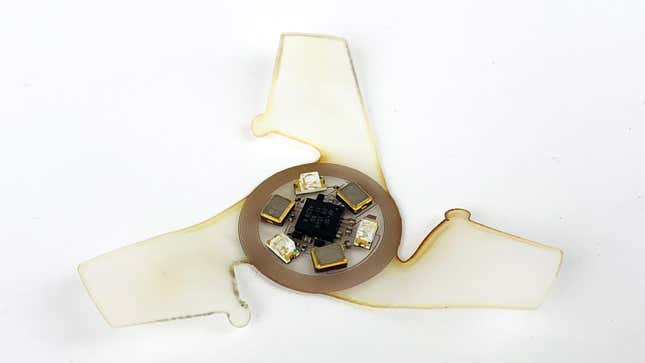
Like helicopter seeds falling slowly towards the ground, these newly created “microfliers” catch the wind to achieve unpowered controlled flight.
New research in Nature affirms the old adage of not wasting time by trying to reinvent the wheel. Engineers from Northwestern University in Evanston, Illinois borrowed heavily from nature to develop microchips capable of passive flight. Called “microfliers,” the tiny devices ride the breeze while falling and leverage the powers of spin to fall in a slow and controlled manner.
The process is akin to helicopter seeds falling from a maple tree, and that’s not a coincidence. The team, led by engineer John Rogers, studied various plants and trees to understand how nature, after millions of years of evolution, stumbled on some rather excellent solutions for disbursing seeds. Wind-blown seeds tend to use one of four different strategies: helicopters, flutterers (or spinners), gliders, and parachuters.
“Evolution was likely the driving force for the sophisticated aerodynamic properties exhibited by many classes of seeds,” explained Rogers in a press release. “These biological structures are designed to fall slowly and in a controlled manner, so they can interact with wind patterns for the longest-possible period of time. This feature maximizes lateral distribution via purely passive, airborne mechanisms.”
The purpose of the project was to find effective ways of distributing functional miniaturized electronic devices and to do so en masse. Dropping thousands of microfliers from planes or tall buildings could enable unique ways of monitoring the environment, such as pollution, toxic spills, and the spread of diseases. Modified microfliers could form powerful interlinked networks composed of hundreds or thousands of nodes, or communicate wirelessly with external devices, acting as sensors in the Internet of Things. The potential applications are practically limitless.
After running tests, the researchers found that helicopter and spinner seeds worked best, especially seeds from the tristellateia plant. The winged bladed seeds from this flowering vine ride the wind, descending slowly as they spin around. The team built a bunch of different tristellateia-like microfliers, including one with three wings instead of the usual five. The microfliers also ranged in size, including versions as tiny as pebbles and even single grains of sand (the smallest versions measured 500 micrometers wide).

Computer simulations showed how air might flow around the various devices, and wind tunnels demonstrated the way aerodynamics were influenced by design tweaks, such as changes to diameter, structure, and wing type. Tests showed that the spinning movement is key, as it serves to stabilize and slow the object’s descent, allowing it to spread farther from its drop-off location. A slow descent is also beneficial in that it allows the device to prolong its monitoring duties while airborne. Impressively, the team says it came up with designs that rival and possibly improve upon the best that nature has to offer.
“We think that we beat nature,” Rogers said. “At least in the narrow sense that we have been able to build structures that fall with more stable trajectories and at slower terminal velocities than equivalent seeds that you would see from plants or trees.”
What’s more, some of their microfliers were considerably smaller than those found in nature.
“That’s important because device miniaturization represents the dominating development trajectory in the electronics industry, where sensors, radios, batteries and other components can be constructed in ever smaller dimensions,” Rogers added.
Another key component of a successful controlled descent is a bit of weight. Without some bulk, the flyer would be blown out of control, and without a low center of gravity, it wouldn’t be able to spin. The good news is that these devices have weight in the form of built-in components, such as microchips, solar cells (or batteries), and antennas. Collectively, those add-ons would provide the microflier with brains, power, and wireless communications.
“This research provides a foundational understanding of these engineered systems and poses some questions to be addressed in future studies,” E. Farrell Helbling, an electrical and computing engineer from the University of Ithaca who wasn’t involved in the study, wrote in an accompanying News & Views article. Specifically, said said, future work should look at “how wind affects the aerodynamics of the fliers,” as the researchers, while considering various environmental factors, still need to investigate wind in more detail. What’s more, “the authors’ results focus on helicopter-and spinner-style dispersal methods, which leaves the design of parachuter- and glider-type fliers to future studies and raises questions about possible trade-offs between spatial range, payload and so on,” wrote Helbling.
In tests, the team demonstrated a 2-inch (5 cm) microflier capable of monitoring particulate matter in the air as it made a slow descent. The team envisions future versions capable of monitoring water quality with pH sensors and sun exposure with photodetectors. Practical applications include the tracking of chemical or oil spills, air pollution at various altitudes, and—perhaps more ominously—human movements.
Indeed, the ethical and legal ramifications of this technology will need to be sorted out to avoid potential abuse, such as the surreptitious tracking of people. The team is also cognizant of the fact that microfliers might eventually become a form of litter or pollutant themselves. To that end, they’re working on versions that dissolve in water or naturally degrade over time. They’re also looking to make microfliers capable of active flight, which will be considerably more challenging.